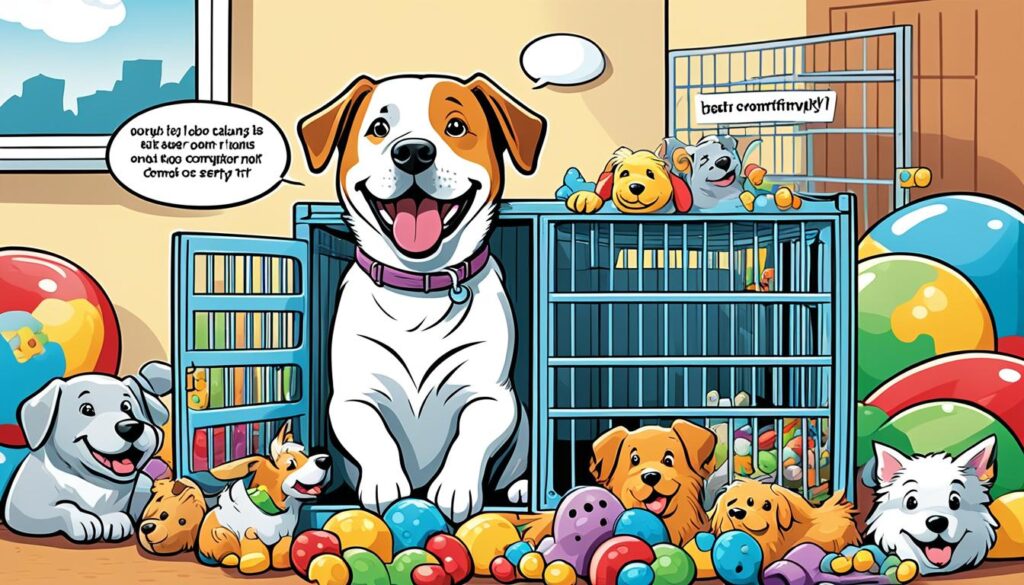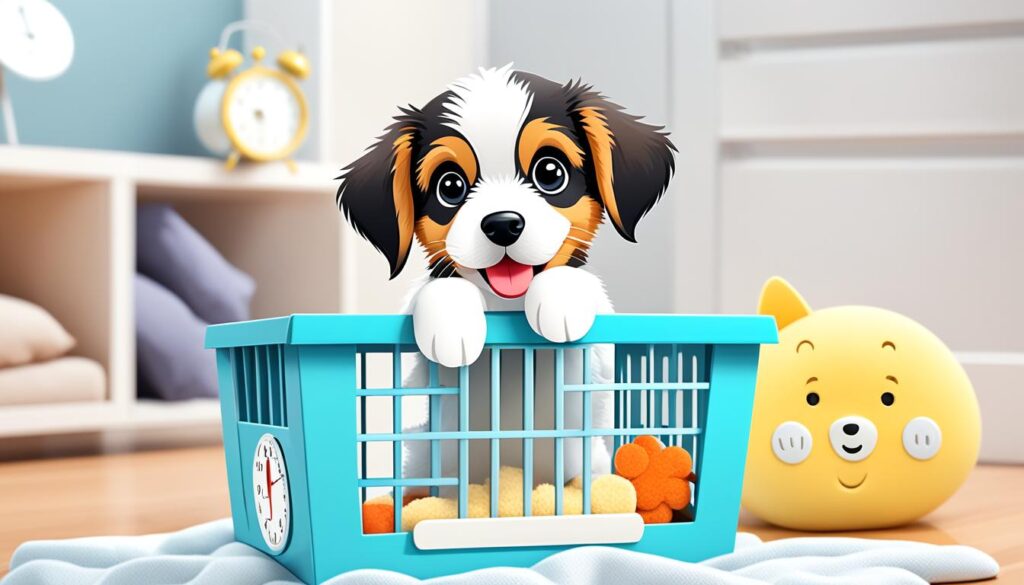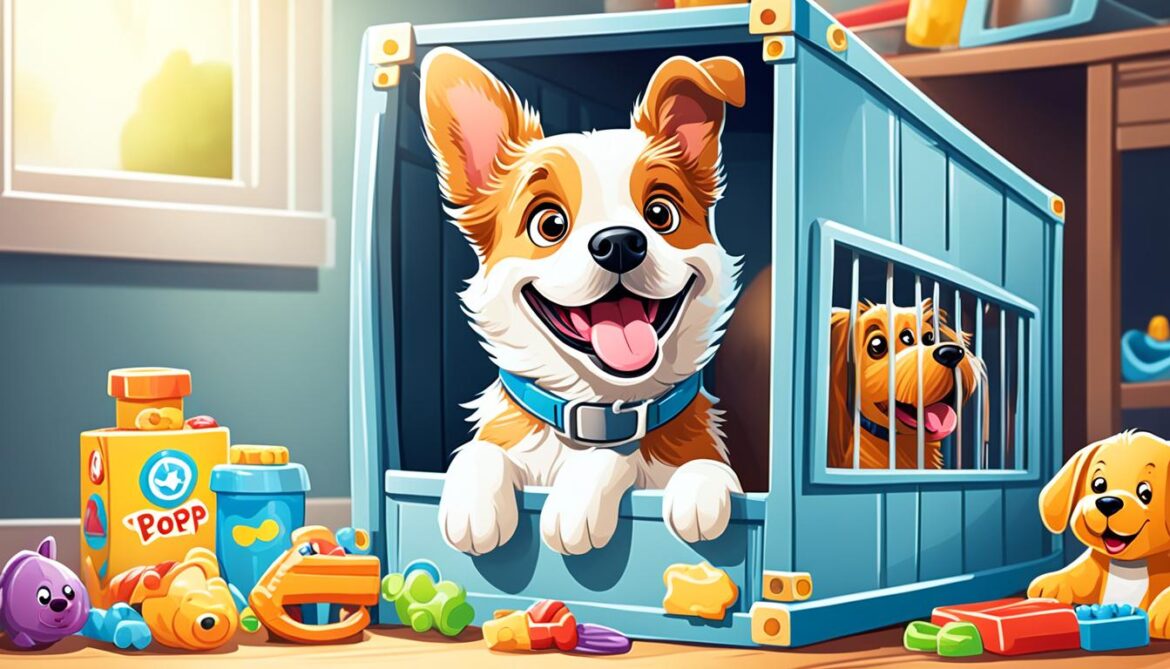Do you remember the first day you brought your furry friend home? The excitement, the anticipation, and the instant connection that formed between you and your beloved companion. It was love at first sight, and from that moment on, you knew you would do anything to make sure they were happy and well-cared for.
But as much as you adore your dog, you also understand the importance of training them to be a well-behaved member of your family. That’s where crate training comes in. Crate training is a tried-and-true method that can help your dog become more comfortable in their own space and learn essential skills.
In this comprehensive guide, we will walk you through the process of crate training your dog, whether they are a brand new puppy or an older dog in need of some training basics. We will provide you with step-by-step instructions, useful tips, and even a sample crate training schedule to ensure a successful training experience.
Key Takeaways:
- Crate training can help your dog become well-adjusted and comfortable in their own space.
- It provides a safe and secure environment for your dog and reduces anxiety and destructive behavior.
- Crate training aids in house training and makes traveling with your dog easier.
- The process of crate training includes introducing your dog to the crate, using positive reinforcement, and gradually extending crate time.
- Essential crate training tips include making the crate inviting, establishing a routine, and avoiding common mistakes.
Why Crate Training is Beneficial for Your Dog
Crate training offers several benefits for both you and your dog. It provides them with a safe and secure space that they can call their own, reduces anxiety and destructive behavior, aids in house training, and makes traveling with your dog easier. Understanding the advantages of crate training will help motivate you to embark on this training journey with your furry friend.
When you crate train your dog, you give them a designated area where they can feel protected and relaxed. Dogs are den animals by nature, and a crate simulates a cozy den-like environment. This secure space becomes their sanctuary, providing a sense of comfort and security. It can be especially beneficial for anxious or fearful dogs, as it gives them a retreat to retreat when they feel overwhelmed.
“Crate training provides dogs with a safe and secure space, reducing anxiety and making them feel comfortable.”
Crate training also helps address destructive behavior in dogs. When left unsupervised, dogs may chew furniture, shoes, or other household items. However, crate training allows you to confine your dog in a safe space, protecting your belongings while preventing them from engaging in destructive behavior. By providing appropriate chew toys and stimulating activities in the crate, you can redirect their chewing behavior and keep them entertained.
“Crate training aids in reducing destructive behavior and protects your belongings.”
In addition, crate training plays a crucial role in house training your dog. Dogs naturally avoid soiling their sleeping area, so the crate helps them develop bladder and bowel control. By using the crate consistently and taking your dog outside for regular bathroom breaks, you can establish a routine that promotes successful house training. Gradually, as your dog learns to hold their bladder and bowels, you can extend the time they spend outside the crate.
Traveling with your dog becomes significantly easier when they are crate trained. Whether you’re going on a road trip or flying, having a crate-trained dog allows you to provide them with a familiar and secure space during transit. It also ensures their safety and prevents any potential accidents or injuries while on the move.
“Crate training aids in house training and makes traveling with your dog more convenient and safe.”
| Benefits of Crate Training | Explanation |
|---|---|
| Provides a safe and secure space for your dog | A crate gives dogs a den-like environment to relax and feel protected. |
| Reduces anxiety and destructive behavior | Crate training helps to calm anxious dogs and prevents them from engaging in destructive behaviors. |
| Aids in house training | By using the crate consistently, dogs learn to develop bladder and bowel control, making house training easier. |
| Makes traveling with your dog easier | A crate provides your dog with a familiar and secure space during transit, ensuring their safety and convenience. |

Understanding the benefits of crate training will not only enhance your dog’s well-being but also strengthen the bond between you and your furry companion. So, let’s dive into the next section to learn how to effectively crate train your puppy.
How to Crate Train a Puppy: Step-by-Step Guide
When it comes to crate training a puppy, patience, consistency, and positive reinforcement are key. In this section, we will provide you with a step-by-step guide to crate training your adorable furry friend. By following these tried and tested methods, you can ensure a smooth and successful training experience.
1. Introducing Your Puppy to the Crate
The first step in crate training is introducing your puppy to their new crate. Place the crate in a location where your puppy can see and smell it. Leave the door open and let them explore the crate at their own pace. Encourage them with treats, toys, and praise whenever they show interest or enter the crate voluntarily.
2. Getting Your Puppy Comfortable Inside
Once your puppy has become familiar with the crate, it’s time to make it their cozy space. Line the crate with soft bedding or a crate mat to provide comfort. Place their favorite toys or a chew toy inside to keep them entertained. Gradually increase the amount of time they spend inside the crate, starting with short periods and gradually extending it.
3. Using Crate Training for Potty Training
Crate training can be a useful tool for potty training your puppy. Dogs naturally avoid soiling their sleeping area, so the crate can help teach them bladder control. Take your puppy outside to eliminate before placing them in the crate. Establish a regular schedule for bathroom breaks, and always reward them for going outside. Avoid using the crate as a punishment for accidents.
4. Gradually Extending Crate Time
As your puppy becomes more comfortable with the crate, you can gradually increase the amount of time they spend inside. Start by leaving them alone in the crate for short periods while you’re still at home. Gradually increase the duration, ensuring they have plenty of positive reinforcement and have had an opportunity to eliminate before being crated for longer periods.

5. Different Crate Training Methods and Techniques
There are various crate training methods and techniques available. It’s crucial to find an approach that works best for your puppy’s temperament and personality. Some popular methods include gradual desensitization, using positive reinforcement, and crate games. Experiment with different techniques and monitor your puppy’s progress to determine the most effective method.
By following this step-by-step guide and being consistent with your training efforts, you can successfully crate train your puppy and provide them with a safe and comfortable space of their own.
Essential Crate Training Tips and Supplies
When it comes to crate training your dog, there are a few essential tips and supplies that can make the process smoother and more successful. From creating an inviting space to selecting the right tools, these guidelines will help you set your furry friend up for crate training success.
Making the Crate Inviting
It’s important to make your dog’s crate a welcoming and comfortable space. Place soft bedding, such as blankets or towels, inside the crate to provide a cozy environment. You can also add a familiar item, like a shirt with your scent, to help your dog feel secure. Remember, the crate should never be used as a form of punishment, so make it a positive and inviting place.
Using Treats and Rewards
Positive reinforcement is key to successful crate training. Use treats and rewards to encourage your dog to enter the crate willingly and stay inside for longer periods of time. Start by tossing treats near the crate and gradually move them inside, rewarding your dog for each step they take. You can also provide their meals inside the crate to create positive associations.
Establishing a Crate Routine
Consistency is essential when crate training your dog. Establish a regular schedule for crate time, including meal times, play sessions, and quiet rest periods. By following a consistent routine, your dog will learn to anticipate and accept crate time as a normal part of their day.
Avoiding Common Mistakes
While crate training, it’s important to avoid common mistakes that can hinder progress. Never force your dog into the crate or use it as a means of confinement for extended periods. This can create negative associations and lead to anxiety. Additionally, avoid letting your dog out of the crate when they are whining or barking, as this rewards their behavior and may delay the training process.
| Crate Training Tips | |
|---|---|
| Make the crate inviting with soft bedding and familiar scents. | |
| Use treats and rewards to create positive associations with the crate. | |
| Establish a consistent crate routine to help your dog adjust. | |
| Avoid common mistakes, such as forcing your dog into the crate or rewarding whining. |
By following these essential tips, you can ensure a successful crate training experience for you and your dog. Remember, patience and positive reinforcement are key to helping your furry friend feel secure and comfortable in their crate.
Conclusion
Crate training is an effective and humane method to teach your dog essential skills and provide them with a safe and comfortable space. By following this guide, you can establish a positive crate training experience that will benefit both you and your canine companion for years to come.
Consistency is key when crate training your dog. Stick to a regular schedule and always use the crate as a positive and rewarding space. With patience and lots of praise, your dog will soon learn to love their crate and view it as their own cozy den.
Remember, crate training is not about confinement, but rather about creating a secure environment where your dog feels relaxed and at ease. By introducing crate training gradually and making it a positive experience, you can help foster a bond of trust and provide your dog with a sense of security.
